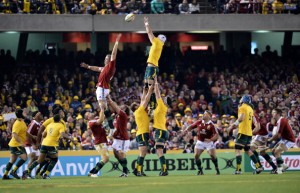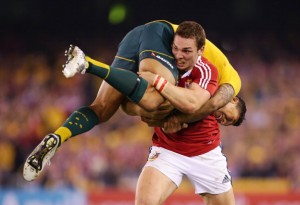
Captain's performance: Sam Warburton drives deep into the Wallaby half but is now a doubt for the deciding Test
By Paul Williams
The pendulum has swung
THE LIONS lost the second test, and the Series momentum, in what was a tense, absorbing 15–16 defeat to the Wallabies. The Lions can have no argument with this loss. Both the scrum and, to a lesser extent, the lineout, were fragile – the scrum was such an ‘Achilles heel’ in the first half that it was worthy of amputation. The inability to consistently secure ball from the set piece contributed to the Lions gaining an alarmingly low 36% territory and 37% possession – in fact the score was surprisingly close when you consider the disparity in these key stats.
This isn’t to say that there weren’t any positives – there were. The breakdown was refereed as a contest which allowed Sam Warburton to thrive and to deliver his finest performance of the tour. The defensive line was solid and Leigh Halfpenny’s goal-kicking was once again above test standard – so good, in fact, that many drew breath even when he missed a mammoth 50 yarder. But this tour is no longer about taking positives – it’s about taking chances. The Lions have one left.
Lineout issues remain
On paper the Lion’s lineout functioned well – losing just one. However the quality of the possession secured wasn’t as clear cut. As has often been the case during this tour securing safer front and middle ball wasn’t a big issue – with the exception of the Lion’s final lineout from which Liam Gill leapt on the loose ball and won a penalty. But the ‘moneyball’ at the tail of the lineout once again eluded the Lions when it mattered – on two occasions the Lions squandered ball at the tail. Ball from the tail of the lineout is the highest quality possession available in modern rugby, particularly with the current instability of elite scrums.
A seven-man lineout guarantees that all of the opposition’s forwards are out of the defensive line – which sits a full ten metres away. However, a messy ‘tap-down’ negates all of the advantages. Messy lineout possession requires the scrum half to wait for the ball to bounce, change his body shape and, often, the hand from which he passes – taking anything up to two seconds. A typical test back can cover 40 metres in 5.5 seconds, meaning that during a two second lineout ‘fumble’ the defensive line has moved up approximately seven yards. Seven yards was like seven miles in a game test match of this magnitude.
Scrum collapse
The scrum has so far been one of the Lion’s strengths – in the second test, it became a crippling weakness. We haven’t seen such a rapid transition from strength to weakness since Samson nipped to the barbers and asked for a ‘Grade 1’. During the first half the Lion’s scrum conceded six points as a direct result of scrum penalties – two thirds of the Wallabies first half points haul.
That is a sizeable concession of points when you consider that the two test matches have so far been decided by a combined margin of just three points. Many will blame Mako Vunipola, solely, for the failure, but that’s unfair. The scrum weakness wasn’t solely the loose-head’s fault – as the introduction of Richard Hibbard, a hooker, proved. A front row of Hibbard and Alex Corbisiero appears necessary for the final test.
No gainline means no clean-breaks
For the first time on this tour, the Lions failed to make a single clean-break. But the lack of clean-breaks wasn’t the problem, it was the symptom. The problem was an inability to get over the gainline. If you consistently make it over the gainline, defensive lines need to scramble and thus defensive mismatches arise – quickly followed by the elusive clean-breaks. Due to a lack of possession and an unreliable set piece, the Lions laboured their way over the gainline and were consistently forced to carry the ball into well defended channels or kick possession away.
The paucity of gain-line carries and clean breaks were further compounded by the team selection and on-going injury crisis. When the gainline is difficult to cross you need players who thrive in that scenario. This was a game made for Jamie Roberts and Mike Phillips. I suspect next week will be too.
The iconic George North
In truth, by his own vertigo inducing high standards, George North failed the make the impact in the second Test that he did in the first. He dived out of the defensive line and Israel Folau caused him problems when collecting cross-field kicks. However it is the sign of a world class player that even when things haven’t gone your way that you create an iconic moment of rugby history. North popping Folau on his shoulder will live long in the memory of supporters – and Israel Folau’s.
It was as audacious a show of strength as you will ever see on the rugby field. Folau is 6ft 4inches tall and weighs 16 stone 2lbs – yet George North, whilst moving backwards, flicked him up over his shoulder like a piece of old kitchen linoleum and carried him six yards backwards. Of course, whilst North’s freakish power raised a cheer and a laugh from the Lions supporters, it was Folau and his chums who, in the end, laughed loudest.







